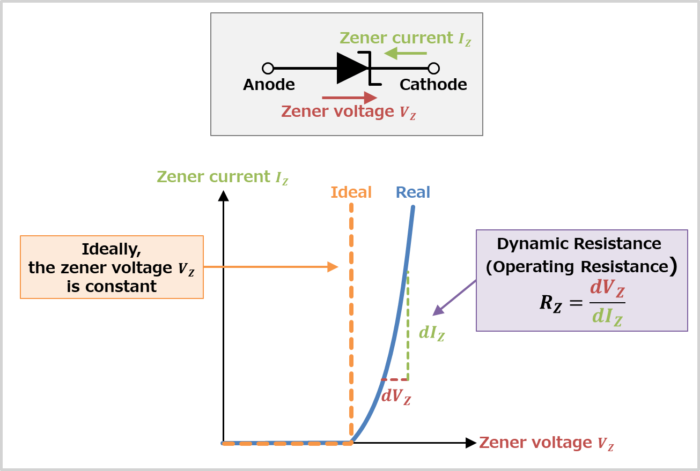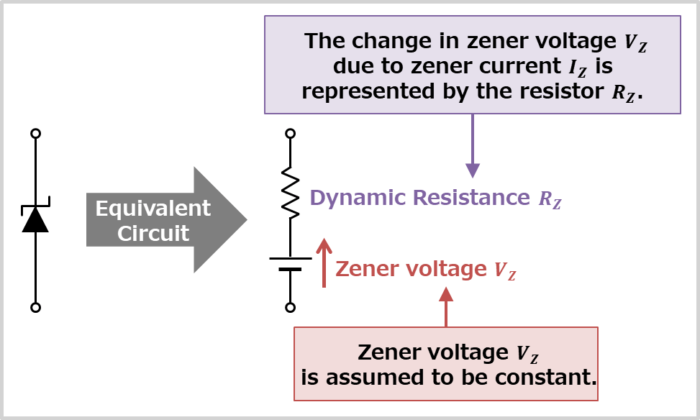This article explains "Resistance (Impedance) of Zener Diode".
In the zener diode, when the zener current \(I_Z\) changes, the zener voltage \(V_Z\) changes slightly. The slope of the Zener voltage \(V_Z\) and the Zener current \(dV_Z/dI_Z\) is called the resistance (or impedance) of zener diode.
Now, I will explain "Resistance (Impedance) of Zener Diode" in detail using diagrams.
Resistance (Impedance) of Zener Diode

The above figure shows the "Zener current \(I_Z\)-Zener voltage \(V_Z\) characteristic" of the zener diode.
Ideally, the zener voltage \(V_Z\) of the zener diode should remain constant even when the zener current \(I_Z\) changes.
In reality, however, the Zener voltage is not perfectly constant, and as the Zener current \(I_Z\) changes \(dI_Z\), the Zener voltage \(V_Z\) changes \(dV_Z\). Therefore, the "Zener current \(I_Z\) - Zener voltage \(V_Z\) characteristic" has a slope.
This slope is the resistance \(R_Z\) of the zener diode. The resistance \(R_Z\) of the zener diode is expressed by the following equation.
\begin{eqnarray}
R_Z=\frac{dV_Z}{dI_Z}
\end{eqnarray}
The resistance \(R_Z\) of the zener diode is called its dynamic resistance (or operating resistance).
Supplement
- The symbols for the resistance of the zener diode are commonly represented by \(R_Z\), \(Z_Z\), \(R_{ZT}\), \(Z_{ZT}\), and \(r\).
- Ideally, the zener diode has a constant zener voltage \(V_Z\) (\(dV_Z = 0\)) even when the zener current \(I_Z\) changes, so the ideal value of the resistance \(R_Z\) of the zener diode is zero.
- The smaller the resistance \(R_Z\) of the zener diode, the smaller the change in zener voltage \(V_Z\) when the zener current \(I_Z\) changes, and thus the higher the performance of the zener diode.
- The resistance \(R_Z\) of the zener diode varies with the zener current flowing through it. Therefore, when a certain amount of current is applied, the resistance \(R_Z\) becomes smaller, resulting in better stability of the zener voltage \(V_Z\).
- The resistance \(R_Z\) of the zener diode tends to increase at the rise of the zener diode (when current begins to flow). The operating resistance at the rise is called "Rise Dynamic Resistance (Rise Operating Resistance) \(R_{ZK}\)". Rise operating resistance will be explained later.
Equivalent Circuit of Zener Diode

Using the resistance \(R_Z\) of the zener diode, the equivalent circuit of the zener diode is shown in the figure above.
The equivalent circuit of the zener diode can be represented by a series connection of the zener voltage \(V_Z\) and the resistor \(R_Z\). In the equivalent circuit, the zener voltage \(V_Z\) is assumed to be constant, and the change in zener voltage \(V_Z\) due to zener current \(I_Z\) is represented by the resistor \(R_Z\).
Rise Dynamic Resistance (Rise Operating Resistance) of Zener Diode

The resistance at the rising edge of the zener diode is called 'Rise Dynamic Resistance (Rise Operating Resistance) \(R_{ZK}\)' and is listed on the datasheet.
The above figure shows a part of the datasheet for Panasonic DZ2J062x0L. It can be seen that the rise dynamic resistance (rise operating resistance) \(R_{ZK}\) is 100Ω when the zener current \(I_Z = 0.5{\mathrm{mA}}\) is applied.
It can also be seen that as the zener current increases and \(I_Z = 5{\mathrm{mA}}\), the resistance \(R_Z\) of the zener diode becomes 30 Ω.
Supplement
- The symbols for the rise dynamic resistance of the zener diode are commonly represented by \(R_{ZK}\) or \(Z_{ZK}\).
Summary
In this article, the following information on the "Resistance (Impedance) of Zener Diodes" was explained.
- Resistance (Impedance) of Zener Diode
- Rise Dynamic Resistance (Rise Operating Resistance) of Zener Diode
Thank you for reading.
Related article
"Information about Zener diodes" is explained in detail in the following articles. If you are interested, please check it out from the link below.